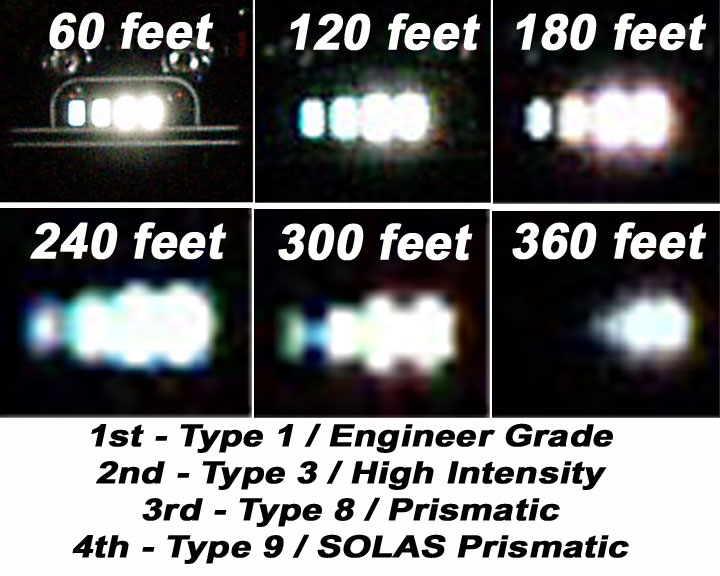Difference Between Glass Bead & Prismatic Reflective Tape – (www.tapedealer.com)
There are two types of reflective tape, glass bead and prismatic. Glass bead tapes were the first reflective tapes and then in the 1960’s prismatic tape was invented by Reflexite. It is interesting that prismatic tapes have not replaced glass bead tapes. Even after 50 years. This is because both have characteristics that make them desirable in certain situations.
Glass Bead Reflective Tapes
Glass bead tapes use microscopic glass spheres to bend and reflect light back to the light source. Because of the imperfections and curved surfaces in glass beads, tapes made with beads are less reflective than tapes made with prisms. Glass bead tapes are about 30% efficient. This is a disadvantage. However, there are three advantages that glass bead tape has over most prismatic tapes. First, glass bead reflective tapes are much more affordable. This is because they are simpler to manufacture. Second, most glass bead tapes are CAD cuttable meaning that you can cut letters, number and designs out of the tape and create reflective signs or graphics. Third, glass bead tapes reflect light back at wider angles. In other words, glass bead tapes are sort of like flood lamps whereas prismatic tapes are more light spot lights. The diagram below shows this.
As you will notice from the diagram above, the glass bead tape disperses light more than prismatic tape. That is why it is not as bright at farther distances. However, at close distances the wider angle of dispersion can be an advantage. Let say for example that a fireman is wearing a high intensity glass bead tape on his equipment. When someone shines a light towards him the tape will light up for the person with the light and, if you are fairly close, it will light up for you as well. Also, as the beam nears the fireman, his tape lights up quickly. Again, this is because of the dispersion of the light. Many people prefer the high intensity glass bead tape for close up applications. For long distance applications the prismatic is always better. This is because the glass bead tapes completely disappear at a distance of a few hundred yards whereas a prismatic tape is still visible for over a thousand yards or more.
There are two basic types of glass bead reflective tapes. The first is a standard engineer grade or type 1 tape. White engineer grade tape reflects at about 75 candlepower. This is the most popular tape and is found on car tags, stop signs, speed limit signs, emergency vehicle striping and graphics, etc.. The second type is high intensity or type 3 tape. This tape has higher index beads and encapsulates them in a honeycomb pattern. White high intensity tape reflects at about 250 candlepower. You will find this type of tape on traffic cones and road barrels.
Prismatic Reflective Tape
Prismatic is more efficient and returns about 80% of the light sent to it. Therefore it is brighter than glass bead tapes. Prismatic tape reflects light via man made prisms. Since the mirrors are flat and not curved they are more efficient. The light sent from the tape is more focused and can therefore travel farther still be seen. For long distance applications like DOT regulated trucks or coast guard search and rescue a prismatic tape is a must. There are several grades of prismatic tape starting with a type 4 and going up to a type 8. Because they are all so bright, to the human eye there is very little noticeable difference in the various prismatic types. It is when you get far away from the tape that you notice a difference. The farther away you need to see the tape the higher the type needs to be. The brightest tape that I know of is SOLAS coast guard approved tape. It is used for offshore applications and is vital for search and rescue operations where the victim may be a thousand or so yards away.
Many prismatic tapes are too thick to CAD cut. The exception would be Oralite metallized prismatic tapes. Oralite (formerly Reflexite) invented prismatic tapes and makes their metallized tapes in a thin single layer. This has two advantages. Number one, the tape will not delaminate like the thicker tapes. Number two, it can be CAD cut with a vinyl cutter/plotter. This is a huge advantage. Prismatic graphics show up several times farther than standard glass bead graphics. The advantages of this are obvioius.
Some different types of prismatic tapes are DOT C2 Tape, FRA Railcar Tape, SOLAS coast guard tape, School Bus Tape, Chevron Reflective Striping, and Sign Sheeting.
In summary, both glass bead and prismatic tapes have their purpose and will continue to keep people safe and visible for years to come.



